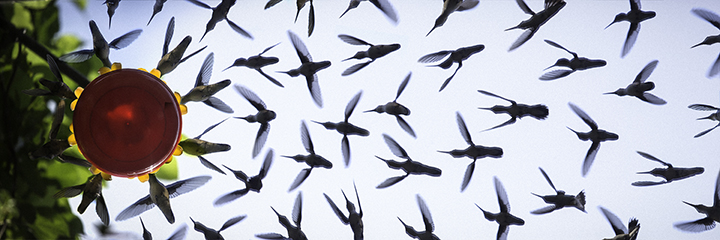Words and Pictures by Brian Maffitt
Some photos capture a fleeting moment in time, and are created in an instant. Other images take more time to develop. My latest viral image, “Hummingbird Swarm”, took three days of patient work to complete… and fewer than 24 hours to become “internet famous”.
I wanted to experiment with something new on a Saturday in August, rigging up an angled mirror beneath one of our hummingbird feeders on my back patio in Chestnut Ridge, NY.
A square mirror, propped up
on a Manfrotto tripod using
a laptop mount as a brace.
A bit clunky but it worked.
The patio faces west, and on most days the setting sun provides an hour or so to photograph the local birds with dramatic backlighting, revealing beautiful and dramatic features of their anatomy.
A magnificent male cardinal,
taking off from the feeder.
For this experiment, I suspected that our local ruby throated hummingbirds, silhouetted against a bright afternoon sky, would create a pleasant image.
But why use a mirror, instead of placing the camera beneath the feeder pointing straight up? Two main reasons:
1) I wanted to be able to quickly adjust the camera on the fly to account for any exposure changes as the sun’s position shifted, and 2) Hummingbird poop.
Bombs away!
Cleaning tiny blobs of bird-excrement off of my camera gear was not something I looked forward to, so instead I removed a decorative mirror from its frame and mounted it on a Manfrotto tripod, located approximately 18 inches below the feeder, angled at about 45 degrees. Then, I positioned myself on a comfortable piece of patio furniture with My Canon EOS 5D Mk III and a 100-400 zoom lens, and waited.
And waited. Nothing happened. Apparently the hummingbirds were afraid of the new mirror, and so avoided the feeder, even as other birds dropped by to investigate.
This trio of tufted titmouses–yes,
that’s the plural of “titmouse”,
even if “titmice” sounds better –
were happy to pose.
I left the mirror in place for a day to let the hummingbirds adjust. On Sunday, things went better. The hummingbirds, mostly females, were plentiful, and had accepted the presence of the new gear. Soon enough they were visiting the feeder, hovering in and out of frame, producing a wealth of opportunities for good shots. Of course, the photogenic hummers were providing other opportunities away from the feeder as well:
There’s that backlighting
I was talking about.
I shot for about 4 hours, cleaning the mirror several times along the way (poop, along with droplets of sticky nectar), until a few hundred RAW images filled up my card.
Early in the process I decided I would be creating a composite image instead of just looking for one “winner”. I’ve done this before many times, combining image sequences to represent a subject in motion.
I identified and flagged approximately 80 promising images in Adobe Lightroom, selected them, then right-clicked and chose “merge to Photoshop layers”, creating a massive Photoshop file. I was grateful for my 64GB of RAM on my main rig. Even so, it took about 8 hours of diligent Photoshop work to produce the final result; each individual bird had to be carefully color-corrected, masked and positioned to complete the giant composite.
I took a clean pic of the sky and placed it behind all
of the hummingbird layers. Each layer used the
“Multiply” blend mode to unify their color space with
the slight blue tint in the sky, and most layers required
a layer mask to paint out any stray edge artifacts.
Thinking I had something cool, I submitted a low-resolution version to Reddit.com on Monday night, where it quickly rose to the front page, and within 24 hours had generated nearly 2 million views on hosting site imgur.com.
TECHNICAL SPECS
Image: 11,520px x 3840px, 72 layers at 64 bits
Camera: Canon Eos 5D Mark III, Canon 100-400 Zoom Lens, Manfrotto Carbon-fiber Tripod, Cabled Remote
Mirror Rig: Manfrotto Carbon-fiber Tripod, DigiPlate laptop adapter (to attach the mirror to the tripod)
Computers: Macbook Pro for initial Capture, finished on a Windows PC (I needed the extra RAM)
Software: Adobe Lightroom CC 2015, Adobe Photoshop CC 2015
PERSONAL INFO
Brian Maffitt is a Photographer, Artist and Educator and lives with his wife and many pets in Chestnut Ridge, NY. As a photographer he received international attention in 2012 for his series of photos called “Projector Snow” (Google it).
Twitter: @bmaffitt
Facebook: Brian Maffitt
Blog: totaltraining.com/blog
Web Site: brianmaffitt.com
Email: brian@totaltraining.com
